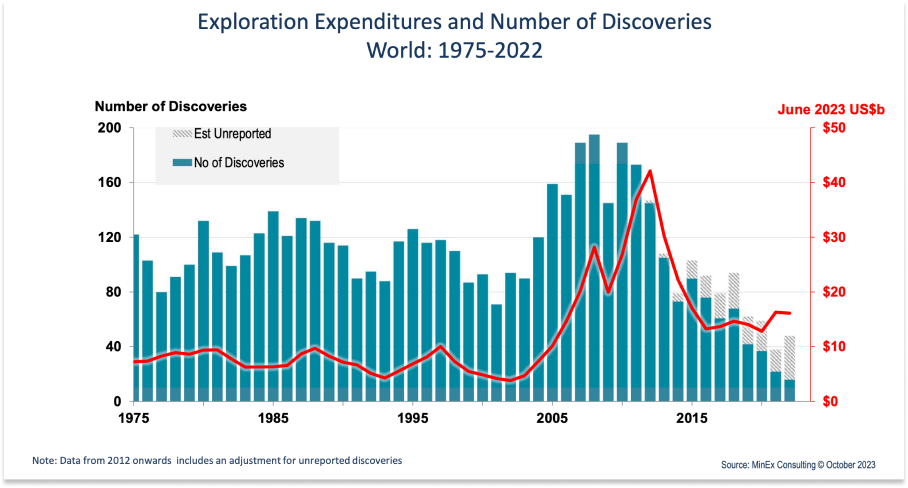From Stone Tools to Silicon Chips: A 43,000-Year Quest for Earth's Hidden Wealth
The story of mining is as old as humanity itself. Take the Ngwenya Mine in Eswatini, radiocarbon dating reveals that our ancestors were extracting specular charcoal as far back as 43,000 years ago.
Forty-three THOUSAND years ago.
Then there’s the dubious history of silver:
For millennia, the methods of extraction remained remarkably similar to those of the ancient Swazis – a reliance on muscle and simple tools to access resources close to the surface. We did move on to picks, levers and sluice boxes but it wasn’t arguably until 1867 and Alfred Nobel’s invention of dynamite that mining entered a modern age.
And that’s just extraction. Finding ores was equally anachronistic. Moving from pure luck, to analyzing surface rocks and outcroppings to sediment analysis. There were advances, but nothing to write home about.
Mining is vital. I mean we have named two of humanities the Bronze and Iron Age for a reason. And nobody can doubt how pivotal innovations like the Bessemer process, made steel and aluminum cheap and abundant, powered the Enlightenment and Industrial Revolution.
The mining industry faced a confluence of escalating challenges. The low-hanging fruit had largely been picked, meaning that finding new, substantial ore bodies became an increasingly expensive and perilous endeavor. Exploration teams relied on traditional geological surveys, geochemical analysis, and geophysical techniques – time-consuming and often imprecise methods that yielded diminishing returns. The costs associated with exploration soared, encompassing extensive fieldwork, drilling programs that could run for years with no guarantee of success, and the increasingly complex regulatory and environmental hurdles that made permitting and licensing a protracted and costly process.
Adding to these difficulties was the growing scarcity of readily apparent places to explore. The world’s surface had been extensively surveyed, and the more obvious geological formations indicative of large deposits had largely been investigated. This pushed exploration into more remote, environmentally sensitive, and geologically complex regions, further increasing the financial risks and logistical nightmares. Moreover, the industry faced a demographic challenge, with experienced geologists and geophysicists reaching retirement age and a lack of young talent to replace them, hindering the intellectual firepower needed to tackle these complex exploration problems.
The traditional business model of mining exploration was also inherently risky. Explorers would often spend millions on surveys and drilling with no guarantee of a commercially viable discovery. Success rates were low, and even when a promising deposit was found, proving its economic feasibility through extensive drilling and analysis was a lengthy and expensive process. The financial burden often forced smaller exploration companies to either go bankrupt or sell their discoveries to larger mining corporations, limiting their ability to reinvest in innovation and build long-term advantages. This created an environment where technological advancement in exploration lagged behind other industries.
The fundamental truth remains: we are not running out of metals and minerals, but of the easily and profitably extractable ones. The solution, as always, lies in human creativity and technological advancement.
Enter Earth AI, a company fundamentally rethinking how we discover the critical metals needed for our future. By building a vertically-integrated operation that combines cutting-edge artificial intelligence with its own custom-built drilling technology, Earth AI is transforming the traditionally hit-or-miss world of mineral exploration into a more precise and efficient science. Their AI models are trained on vast datasets of historical mining information, geological surveys, and environmental data, allowing them to identify the precise locations of potential mineral deposits with an accuracy rate 25 times higher than traditional methods.
The results of this AI-driven approach have been remarkable. In its first four drilling attempts, Earth AI achieved a 75% success rate, a stark contrast to the industry average of just 0.5%. Their discovery of a high-grade molybdenum deposit on their second drilling attempt cost a mere $2 million, compared to the industry average of $218 million, and their drilling costs per meter were a quarter of the industry standard. Furthermore, Earth AI retains 100% ownership of this deposit, unlike most explorers who must share ownership. Through strategic Exploration Alliances, they have also made significant discoveries of palladium-platinum-gold-copper-nickel and high-grade lead and silver, demonstrating the broad applicability and effectiveness of their AI-powered exploration.
These early successes highlight the transformative potential of Earth AI's approach. By leveraging AI to drastically improve discovery rates, reduce costs, and accelerate the exploration timeline, they are not just finding more minerals; they are fundamentally changing the economics of the exploration business. Their vertically-integrated model, from AI-powered targeting to efficient in-house drilling, allows them to prove out deposits faster and cheaper, creating a compounding advantage and positioning them as a new breed of highly efficient mineral explorer poised to unlock the vast, untapped wealth beneath our feet.
Ultimately, the integration of artificial intelligence into the age-old practice of mining represents a profound shift with overwhelmingly positive implications for humanity. By dramatically improving the efficiency and success rate of mineral exploration, AI promises to secure the vital supplies of earthly elements needed to power our technological progress and the crucial energy transition. Moreover, by making the discovery process more targeted and less reliant on extensive, often environmentally disruptive, traditional methods, AI holds the potential to significantly reduce both the financial and environmental costs associated with procuring the resources that underpin our modern world, paving the way for a more sustainable and abundant future for all.







Your digging and pursuing such obscure (to me!) yet important slices of current life is edifying and challenging. You go!